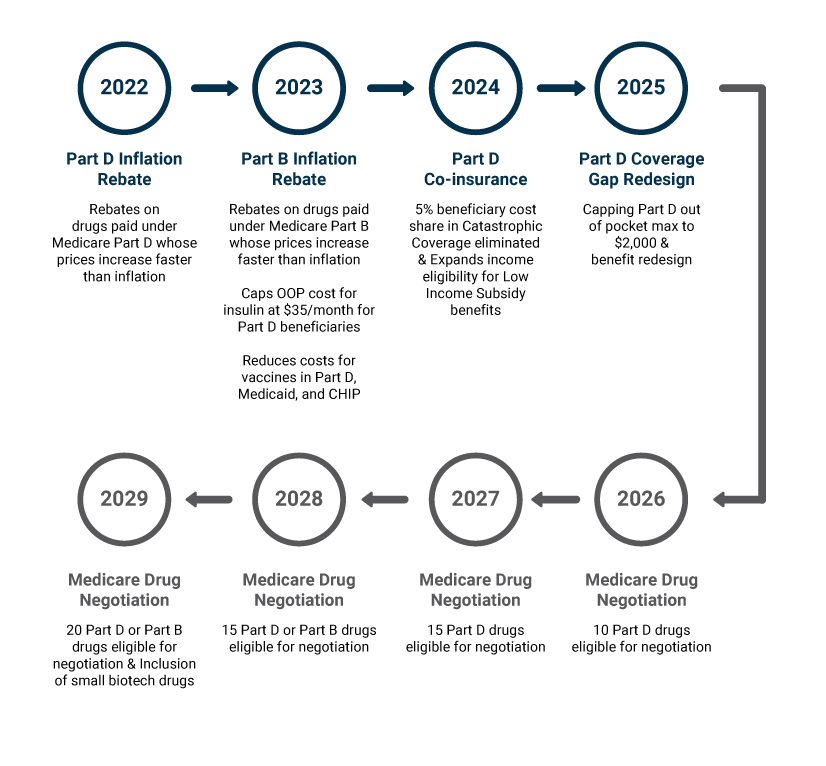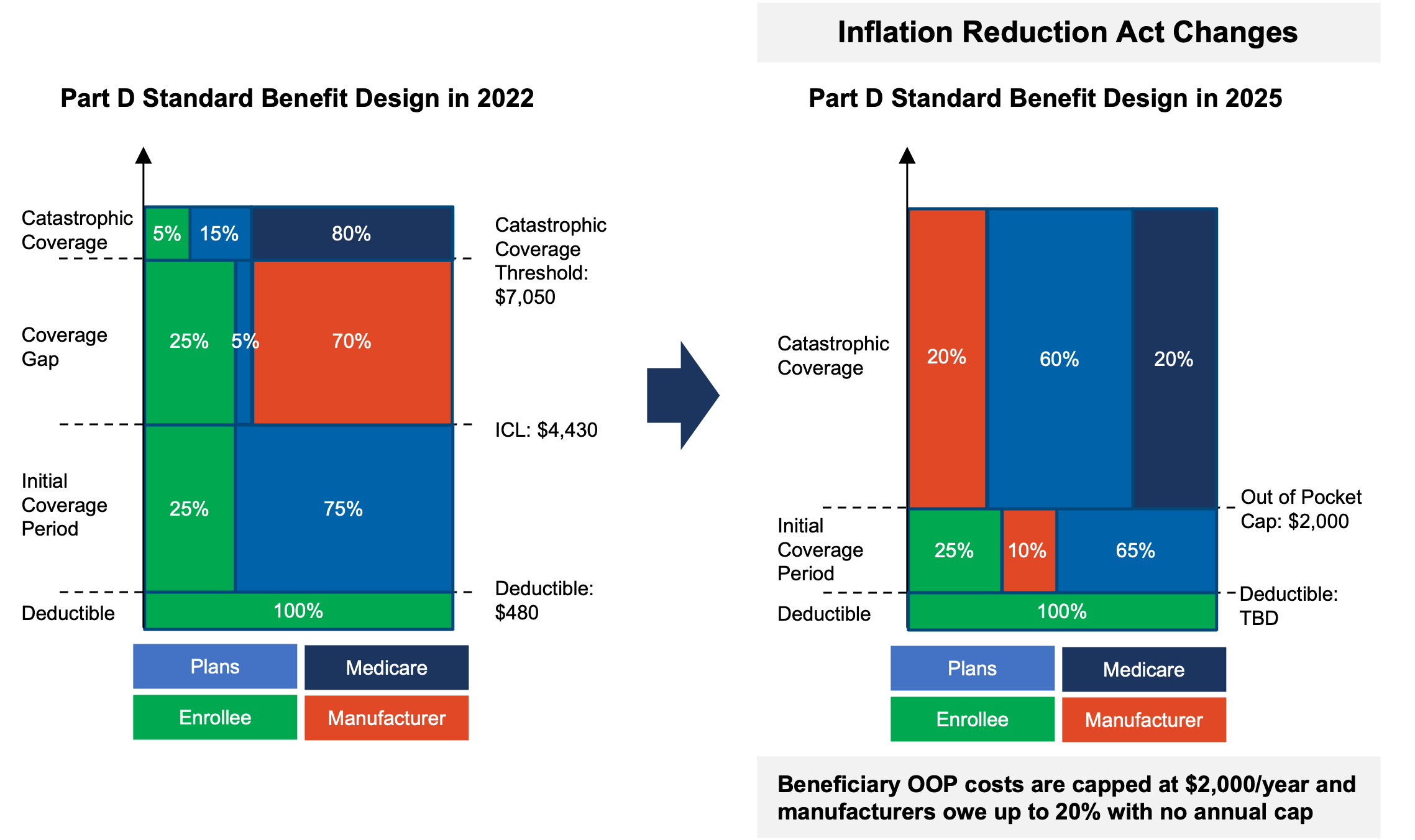Much has been discussed about the Inflation Reduction Act of 2022 and its impact on the Pharma industry. Today, we explore some of the key provisions, their impact on manufacturers, a quick look at the timeline, and some of our initial recommendations.
All in all, the Inflation Reduction Act has given the pharmaceutical industry a lot to digest. At IntegriChain, our team of consultants continue to work through the legislation, ensuring our customers understand the timing of all the moving parts. We have developed a framework to help our customers navigate the regulatory changes and evaluate the potential portfolio impact, deploy models to forecast the financial impact, run scenario modeling to support strategic contracting and pricing decisions, and leverage data assets to fill blind spots.
Upcoming Legislative Dates and Changes

Now let’s walk through the major elements of the act that affect Pharma manufacturers.
Medicare Drug Price Negotiations
Th most talked about provision requires the Federal government – namely the Centers for Medicare and Medicaid Services (CMS) – to “negotiate” prices for Medicare for the first time. While this is unprecedented, it is only for a select set of high expenditure drugs that are among the top expenditures for the program, beginning with 10 Part D drugs and slowly adding more over the next few years. The selected products will increase to 15 Part D drugs in 2027, 15 Part D or Part B drugs in 2028, and 20 Part D or Part B drugs in 2029.
While this provision might only directly impact a limited number of Pharma manufacturers, it will likely have a material impact on those selected products. Further, manufacturers of products that are competitive to those selected for negotiation might need to explore the potential indirect impact to their business when developing a drug pricing strategy.
The “negotiation” process would start by establishing a price ceiling, or Maximum Fair Price (MFP), for selected drugs below which CMS can negotiate additional price concessions. The MFP will establish the ceiling price and will be calculated by taking a percentage off of a drug’s non-Federal Average Manufacturer Price (non-FAMP), which will vary based on the type of drug and the time since approval. The following are the discount percentages off of non-FAMP:
- 40% for products on the market >16 years
- 65% for products on the market >12 years and < 16 years
- 75% for products on the market <12 years
- In 2029 and 2030, 66% for small biotech products
An interesting Government Pricing consideration to keep in mind: the discounts provided through the Medicare Price Negotiation component would be eligible for Medicaid Best Price.
Medicare Part B and D Inflation Rebates
A second key item is the creation of two new types of inflation rebates that will apply to Medicare Part B (excluding multi-source drugs and biosimilar biological products) and Part D (excluding vaccines and certain low-expenditure drugs). This is reminiscent of the inflation rebates in the Medicaid channel but with different benchmark periods and different math.
The Part D inflation rebates are effective October 1, 2022. While they won’t be invoiced for at least a year from then, manufacturers will need to start to accrue for potential liabilities and will need to understand the implications for any prospective price increases. Part B inflation rebates will start in January 2023.
Traditionally, as more than 70% of drug pricing actions occur in January, many manufacturers are now evaluating pricing actions for January 2023, which could be impacted by these two new penalties.
Importantly, these inflation penalties in Part B and Part D are brand new gross-to-net line items that manufacturers must take into account. The nuances of the benchmark periods, measurement periods, and other variables impacting the inflation penalties – such as CPI-U, ASP and AMP variability – can make this forecasting exercise complicated and fraught with uncertainty. It’s important for manufacturers to approach this analysis with the same care that they do with their other impactful gross-to-net line items.
Medicare Part D Benefit Design
The third key item in the act is an overhaul of the Medicare Part D benefit design.These changes include eliminating the 5% out-of-pocket costs beneficiaries currently phase in Catastrophic Coverage, capping out-of-pocket expenses to $2,000 per year, and completely redesigning the structure of what has previously been known as the Coverage Gap Discount Program.
The impact of the redesign begins in 2024 when the 5% patient cost share in catastrophic coverage will shift to the healthcare plan. There is no direct impact to manufacturers with this change, but any change in payer economics can have a ripple effect and impact manufacturers in areas such as contract negotiations. In 2025, the impact of the Coverage Gap redesign will be very material.
Let’s look at the math. Currently, manufacturers are responsible for 70% of the cost of the drug when the patient is in the Coverage Gap. Traditionally, manufacturers might spend up to somewhere between $4,400 and $7,050 per patient, per year (for a patient with a standard benefit design). With the changes coming in 2025, the cap is removed: manufacturers owe either 10% or 20% depending on whether the patient is below or above the $2,000 out-of-pocket cap. The implications are complex and will vary across products, based on a drug’s price, whether it’s acute or chronic, and co-morbidity. Some manufacturers might see liabilities decrease owing to the decrease from 70% to 10% or 20%, but many might see a net increase as they will owe this lesser amount on a higher volume of scrips owing to the liability starting at a lower out-of-pocket-threshold. Manufacturers of more expensive therapies might see the most material change, as liabilities could grow significantly without a cap on annual liability on a per patient basis.
Another wrinkle manufacturers will have to factor into their pharmaceutical pricing strategy is the “phase-in” of rebates for certain drugs dispensed to Low Income Subsidy (LIS) beneficiaries. Manufacturers do not owe Coverage Gap rebates on drugs dispensed to LIS beneficiaries today, but that might change starting in 2025 when rebates of 1% will begin for certain drugs, growing up to 20% by 2031.

Again, there is much for pharma manufacturers to digest and contemplate for their pricing and contracting strategies and for GTN forecasting and accruals. For question on how this may impact your organization, please reach out to consulting@integrichain.com.







